Hydro-Morphological Characteristics Using Flow Duration Curve, Historical Data and Remote Sensing: Effects of Land Use and Climate
Abstract
:1. Introduction
2. Study Area and Methods
2.1. Study Area
2.2. Methods
2.2.1. River Flow Regime Analysis
2.2.2. River Channel Form Changes
3. Results
3.1. Statiscal Analyses of Annual Flow Volumes and FDC
3.2. River Channel Changes
4. Discussion
4.1. Effects of Land Use and Climate
4.2. Implications on Water Resources and New Water Projects
4.3. Limitations and Future Work
5. Conclusions
- River mean, maximum, and minimum streamflow increased, and this is in agreement with rainfall upstream of Tana River basin indicating higher and more variable discharges at Garissa during the recent period.
- The low-flow and maximum discharge increased by 40 and 56% respectively in the current decade from previous years. This is attributable to changes in land use and climatic factors within the watershed.
- The streamflow decreased after regulation and this supports the assertion that the hydroelectric dams may have had an impact on the Tana River flow regime downstream.
- During the study period, the Tana River reach under study experienced channel bank movement, width adjustment, and abandonment.
Author Contributions
Funding
Acknowledgments
Conflicts of Interest
References
- Saleh, F.; Ducharne, A.; Flipo, N.; Oudin, L.; Ledoux, E. Impact of river bed morphology on discharge and water levels simulated by a 1D Saint–Venant hydraulic model at regional scale. J. Hydrol. 2013, 476, 169–177. [Google Scholar] [CrossRef]
- Fuller, I.C.; Large, A.R.; Milan, D.J. Quantifying channel development and sediment transfer following chute cutoff in a wandering gravel-bed river. Geomorphology 2003, 54, 307–323. [Google Scholar] [CrossRef]
- Yang, S.; Zhao, Q.; Belkin, I.M. Temporal variation in the sediment load of the Yangtze River and the influences of human activities. J. Hydrol. 2002, 263, 56–71. [Google Scholar] [CrossRef]
- Surian, N. Channel changes due to river regulation: The case of the Piave River, Italy. Earth Surf. Processes Landforms 1999, 24, 1135–1151. [Google Scholar] [CrossRef]
- Petit, F.; Poinsart, D.; Bravard, J.-P. Channel incision, gravel mining and bedload transport in the Rhône river upstream of Lyon, France (“canal de Miribel”). Catena 1996, 26, 209–226. [Google Scholar] [CrossRef]
- Kohler, T.J.; Stanish, L.F.; Steven, C.; Joshua, K.; Daniel, L.; Baeseman, B.J.; McKnight, D.M. Life in the main channel: Long-term hydrologic control of microbial mat abundance in McMurdo Dry Valley streams, Antarctica. Ecosystems 2015, 18, 310–327. [Google Scholar] [CrossRef]
- Milly, P.C.D.; Wetherald, R.T.; Dunne, K.A.; Delworth, T.L. Increasing risk of great floods in a changing climate. Nature 2002, 415, 514. [Google Scholar] [CrossRef] [PubMed]
- Pumo, D.; Noto, L.V.; Viola, F. Ecohydrological modelling of flow duration curve in Mediterranean river basins. Adv. Water Resour. 2013, 52, 314–327. [Google Scholar] [CrossRef]
- Piégay, H.; Kondolf, G.M.; Minear, J.T.; Vaudor, L. Trends in publications in fluvial geomorphology over two decades: A truly new era in the discipline owing to recent technological revolution? Geomorphology 2015, 248, 489–500. [Google Scholar] [CrossRef]
- Lane, S.N.; Widdison, P.E.; Thomas, R.E.; Ashworth, P.J.; Best, J.L.; Lunt, I.A.; Sambrook Smith, G.H.; Simpson, C.J. Quantification of braided river channel change using archival digital image analysis. Earth Surf. Processes Landforms 2010, 35, 971–985. [Google Scholar] [CrossRef]
- Vogel, R.M.; Fennessey, N.M. Flow duration curves II: A review of applications in water resources planning. J Am. Water Resour. Assoc. 1995, 31, 1029–1039. [Google Scholar] [CrossRef]
- Guzha, A.C.; Rufino, M.C.; Okoth, S.; Jacobs, S.; Nóbrega, R.L.B. Impacts of land use and land cover change on surface runoff, discharge and low flows: Evidence from East Africa. J. Hydrol. Reg. Stud. 2018, 15, 49–67. [Google Scholar] [CrossRef]
- O’Connell, P.E.; Ewen, J.; O’Donnell, G.; Quinn, P. Is there a link between agricultural land-use management and flooding? Hydrol. Earth Syst. Sci. 2007, 11, 96–107. [Google Scholar] [CrossRef]
- Ewen, J.; O’Donnell, G.; Burton, A.; O’Connell, E. Errors and uncertainty in physically-based rainfall-runoff modelling of catchment change effects. J. Hydrol. 2006, 330, 641–650. [Google Scholar] [CrossRef]
- Gordon, N.D.; McMahon, T.A.; Finlayson, B.L. Stream Hydrology: An introduction for Ecologists; John Wiley & Sons: Chichester, UK, 1993. [Google Scholar]
- Smakhtin, V.U. Low flow hydrology: A review. J. Hydrol. 2001, 240, 147–186. [Google Scholar] [CrossRef]
- Zhao, F.; Xu, Z.; Zhang, L. Changes in streamflow regime following vegetation changes from paired catchments. Hydrol. Processes 2012, 26, 1561–1573. [Google Scholar] [CrossRef]
- Vogel, R.M.; Fennessey, N.M. Flow-duration curves. I: New interpretation and confidence intervals. J. Water Resour. Plann. Manag. 1994, 120, 485–504. [Google Scholar] [CrossRef]
- Gurnell, A.; Downward, S.; Jones, R. Channel planform change on the River Dee meanders, 1876–1992. River Res. Appl. 1994, 9, 187–204. [Google Scholar] [CrossRef]
- Bristow, C.S. Brahmaputra River: Channel migration and deposition. SEPM 1987, 63–74. [Google Scholar] [CrossRef]
- Mertes, L.A. Remote sensing of riverine landscapes. Freshw. Biol. 2002, 47, 799–816. [Google Scholar] [CrossRef]
- Ghosh, M.K.; Kumar, L.; Roy, C. Monitoring the coastline change of Hatiya Island in Bangladesh using remote sensing techniques. ISPRS J. Photogramm. Remote Sens. 2015, 101, 137–144. [Google Scholar] [CrossRef]
- Taylor, C. Recognising Channel and Floodplain Forms; Water and Rivers Commission: East Perth, Western Australia, 2002.
- Saenyi, W.; Chemelil, M. Modelling of suspended sediment discharge for Masinga catchment reservoir in Kenya. J. Civ. Eng. JKUAT 2003, 8, 89–98. [Google Scholar] [CrossRef]
- Temper, L. Let Them Eat Sugar: Life and Livelihood in Kenya’s Tana Delta. 2012. Available online: http://www.ceecec.net/case-studies/let-them-eat-sugar-life-and-livelihood-in-kenyas-tana-delta/ (accessed on 20 November 2018).
- Hamerlynck, O.; Nyunja, J.; Luke, Q.; Nyingi, D.; Lebrun, D.; Duvail, S. The communal forest, wetland, rangeland and agricultural landscape mosaics of the Lower Tana, Kenya: A socio-ecological entity in peril. Sustain. Use Biol. Di-Versity Socio-Ecol. Prod. Landsc. 2010, 52, 54. [Google Scholar]
- Leauthaud, C.; Belaud, G.; Duvail, S.; Moussa, R.; Grunberger, O.; Albergel, J. Characterizing floods in the poorly gauged wetlands of the Tana River Delta, Kenya, using a water balance model and satellite data. Hydrol. Earth Syst. Sci. 2013, 17, 3059–3075. [Google Scholar] [CrossRef]
- Maingi, J.K.; Marsh, S.E. Quantifying hydrologic impacts following dam construction along the Tana River, Kenya. J. Arid Environ. 2002, 50, 53–79. [Google Scholar] [CrossRef]
- Koei, N. The Project on the Development of the National Water Master Plan 2030; Final Report; Volume V Sectoral Report (E)—Agriculture and Irrigation; The Republic of Kenya, Water Resources Management Authority: Nairobi, Kenya, 2013. [Google Scholar]
- Conway, D.; Persechino, A.; Ardoin-Bardin, S.; Hamandawana, H.; Dieulin, C.; Mahé, G. Rainfall and water resources variability in sub-Saharan Africa during the twentieth century. J. Hydrometeorol. 2009, 10, 41–59. [Google Scholar] [CrossRef]
- McClain, M.E. Balancing water resources development and environmental sustainability in Africa: A review of recent research findings and applications. Ambio 2013, 42, 549–565. [Google Scholar] [CrossRef] [PubMed]
- Hughes, F.M.R. The Tana River Floodplain Forest, Kenya: Ecology and the Impact of Development. Ph.D. Thesis, University of Cambridge, Cambridge, UK, 1985. [Google Scholar]
- Knoop, L.; Sambalino, F.; Steenbergen, F.V. Securing Water and Land in the Tana Basin: A Resource Book for Water Managers and Practitioners; UNEP/3R Water Secretariat: Wageningen, The Netherlands, 2012. [Google Scholar]
- Agwata, J.F. Water resources utilization, conflicts and interventions in the Tana basin of Kenya. FWU Water Resour. Publ. 2005, 3, 13–23. [Google Scholar]
- Kenya, R.O. High Grand Falls Multipurpose Development Project on River Tana—Feasibility Study; Ministry of Regional Development Authorities: Nairobi, Kenya, 2011. [Google Scholar]
- DHV. Tana River Morphology Studies; Delft Hydraulics Laboratory: Delft, The Netherlands, 1986. [Google Scholar]
- van Beukering, P.J.H.; de Moel, H.; Botzen, W.J.W.; Eiselin, M.; Kamau, P.; Lange, K.; van Maanen, E.; Mogol, S.; Mulwa, R.; Otieno, P.; et al. The Economics of Ecosystem Services of the Tana River Basin; Institute for Environmental Studies: Amsterdam, The Netherlands, 2015. [Google Scholar]
- Baker, T.; Kiptala, J.; Olaka, L.; Oates, N.; Hussain, A.; McCartney, M. Baseline Review and Ecosystem Services Assessment of the Tana River Basin, Kenya; International Water Management Institute (IWMI): Colombo, Sri Lanka, 2015. [Google Scholar]
- Team, R. RStudio: Integrated Development for R; RStudio, Inc.: Boston, MA, USA, 2015. [Google Scholar]
- Dewan, A.; Corner, R.; Saleem, A.; Rahman, M.M.; Haider, M.R.; Rahman, M.M.; Sarker, M.H. Assessing channel changes of the Ganges-Padma River system in Bangladesh using Landsat and hydrological data. Geomorphology 2017, 276, 257–279. [Google Scholar] [CrossRef]
- Ihaka, R.; Gentleman, R. R: A language for data analysis and graphics. J. Comput. Graph. Stat. 1996, 5, 299–314. [Google Scholar]
- Zambrano-Bigiarini, M. Package Hydrotsm: Time Series Management, Analyis and Interpolation for Hydrological Modelling. Available online: https://cran.r-project.org/package=hydroTSM (accessed on 25 October 2017).
- Cisty, M.; Celar, L. Using R in Water Resources Education. Int. J. Innov. Educ. Res. 2015, 3, 223. [Google Scholar]
- NASA. Landsat 7 Science Data Users Handbook; N.A.A.S. Administration: Naas, Ireland, 2011.
- Unger Holtz, T.S. Introductory Digital Image Processing: A Remote Sensing Perspective; Association of Environmental & Engineering Geologists: Portland, OR, USA, 2007. [Google Scholar]
- Chander, G.; Markham, B. Revised Landsat-5 TM radiometric calibration procedures and postcalibration dynamic ranges. IEEE Trans. Geosci. Remote Sens. 2003, 41, 2674–2677. [Google Scholar] [CrossRef]
- Mas, J.-F. Monitoring land-cover changes: A comparison of change detection techniques. Int. J. Remote Sens. 1999, 20, 139–152. [Google Scholar] [CrossRef]
- Coppin, P.; Jonckheere, I.; Nackaerts, K.; Muys, B.; Lambin, E. Review ArticleDigital change detection methods in ecosystem monitoring: A review. Int. J. Remote Sens. 2004, 25, 1565–1596. [Google Scholar] [CrossRef]
- Xu, H. Modification of normalised difference water index (NDWI) to enhance open water features in remotely sensed imagery. Int. J. Remote Sens. 2006, 27, 3025–3033. [Google Scholar] [CrossRef]
- Sunder, S.; Ramsankaran, R.; Ramakrishnan, B. Inter-comparison of remote sensing sensing-based shoreline mapping techniques at different coastal stretches of India. Environ. Monit. Assess. 2017, 189, 290. [Google Scholar] [CrossRef] [PubMed]
- Rokni, K.; Ahmad, A.; Selamat, A.; Hazini, S. Water feature extraction and change detection using multitemporal Landsat imagery. Remote Sens. 2014, 6, 4173–4189. [Google Scholar] [CrossRef]
- Ma, M.; Wang, X.; Veroustraete, F.; Dong, L. Change in area of Ebinur Lake during the 1998–2005 period. Int. J. Remote Sens. 2007, 28, 5523–5533. [Google Scholar] [CrossRef]
- Mann, H.B. Nonparametric tests against trend. Econ. J. Econ. Soc. 1945, 51, 245–259. [Google Scholar] [CrossRef]
- Andrews, E.; Nankervis, J.M. Effective discharge and the design of channel maintenance flows for gravel-bed rivers. Nat. Anthropog. Influ. Fluvial Geomorphol. 1995, 89, 151–164. [Google Scholar]
- Geeraert, N.; Omengo, F.O.; Tamooh, F.; Paron, P.; Bouillon, S.; Govers, G. Sediment yield of the lower Tana River, Kenya, is insensitive to dam construction: Sediment mobilization processes in a semi-arid tropical river system. Earth Surf. Process. Landf. 2015, 40, 1827–1838. [Google Scholar] [CrossRef]
- Magilligan, F.J.; Haynie, H.J.; Nislow, K.H. Channel adjustments to dams in the Connecticut River basin: Implications for forested mesic watersheds. Ann. Assoc. Am. Geogr. 2008, 98, 267–284. [Google Scholar] [CrossRef]
- Piao, S.; Ciais, P.; Huang, Y.; Shen, Z.; Peng, S.; Li, J.; Zhou, L.; Liu, H.; Ma, Y.; Ding, Y.; et al. The impacts of climate change on water resources and agriculture in China. Nature 2010, 467, 43. [Google Scholar] [CrossRef] [PubMed]
- Langat, P.K.; Kumar, L.; Koech, R. Temporal Variability and Trends of Rainfall and Streamflow in Tana River Basin, Kenya. Sustainability 2017, 9, 1963. [Google Scholar] [CrossRef]
- Ioana-Toroimac, G.; Zaharia, L.; Minea, G.; Moroșanu, G.A. Using a multi-criteria analysis to identify rivers with hydromorphological restoration priority: Braided rivers in the south-eastern Subcarpathians (Romania). Sci. Total Environ. 2017, 599, 700–709. [Google Scholar] [CrossRef] [PubMed]
- Gao, B.; Li, J.; Wang, X. Analyzing Changes in the Flow Regime of the Yangtze River Using the Eco-Flow Metrics and IHA Metrics. Water 2018, 10, 1552. [Google Scholar] [CrossRef]
- Vogel, R.M.; Sieber, J.; Archfield, S.A.; Smith, M.P.; Apse, C.D.; Huber-Lee, A. Relations among storage, yield, and instream flow. Water Resour. Res. 2007, 43, 5226. [Google Scholar] [CrossRef]
- Pachauri, R.; Meyer, L. IPCC 2014: Climate Change 2014: Synthesis Report. Contribution of Working Groups I. II and III to the Fifth Assessment Report of the Intergovernmental Panel on Climate Change; IPCC: Geneva, Switzerland, 2014. [Google Scholar]
- Keskinen, M.; Kummu, M.; Käkönen, M.; Varis, O. Mekong at the crossroads: Next steps for impact assessment of large dams. Ambio 2012, 41, 319–324. [Google Scholar] [CrossRef]
- Lemly, A.D.; Kingsford, R.T.; Thompson, J.R. Irrigated agriculture and wildlife conservation: Conflict on a global scale. Environ. Manag. 2000, 25, 485–512. [Google Scholar] [CrossRef]
- Prowse, T.D.; Peters, D.; Beltaos, S.; Pietroniro, A.; Romolo, L.; Töyrä, J.; Leconte, R. Restoring ice-jam floodwater to a drying delta ecosystem. Water Int. 2002, 27, 58–69. [Google Scholar] [CrossRef]
- Min, S.-K.; Zhang, X.; Zwiers, F.W.; Hegerl, G.C. Human contribution to more-intense precipitation extremes. Nature 2011, 470, 378. [Google Scholar] [CrossRef] [PubMed]
- Pender, G.; Faulkner, H. Flood Risk Science and Management; John Wiley & Sons: Hoboken, NJ, USA, 2010. [Google Scholar]
- Langat, P.K.; Kumar, L.; Koech, R. Monitoring river channel dynamics using remote sensing and GIS techniques. Geomorphology 2019, 325, 92–102. [Google Scholar] [CrossRef]
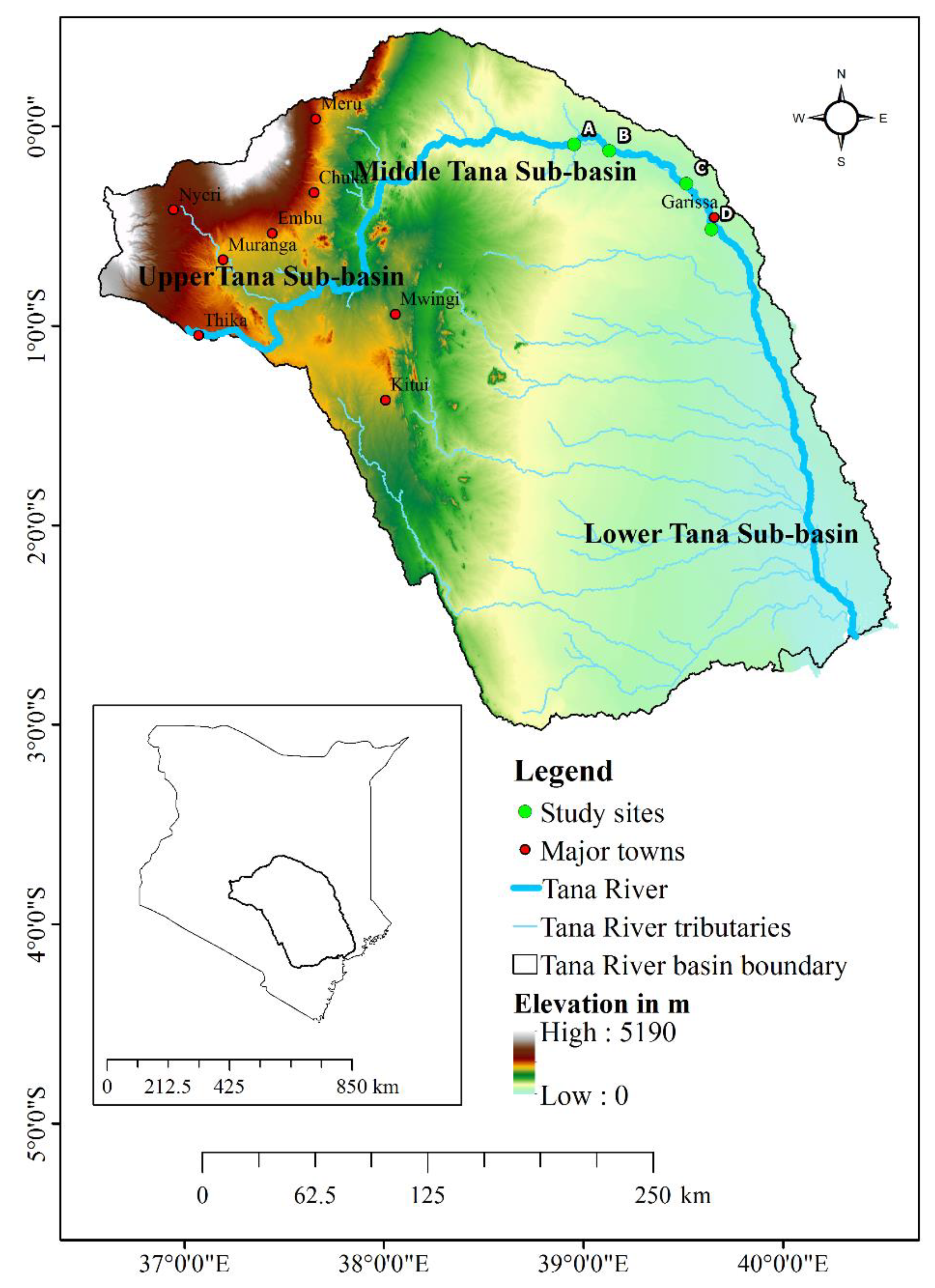
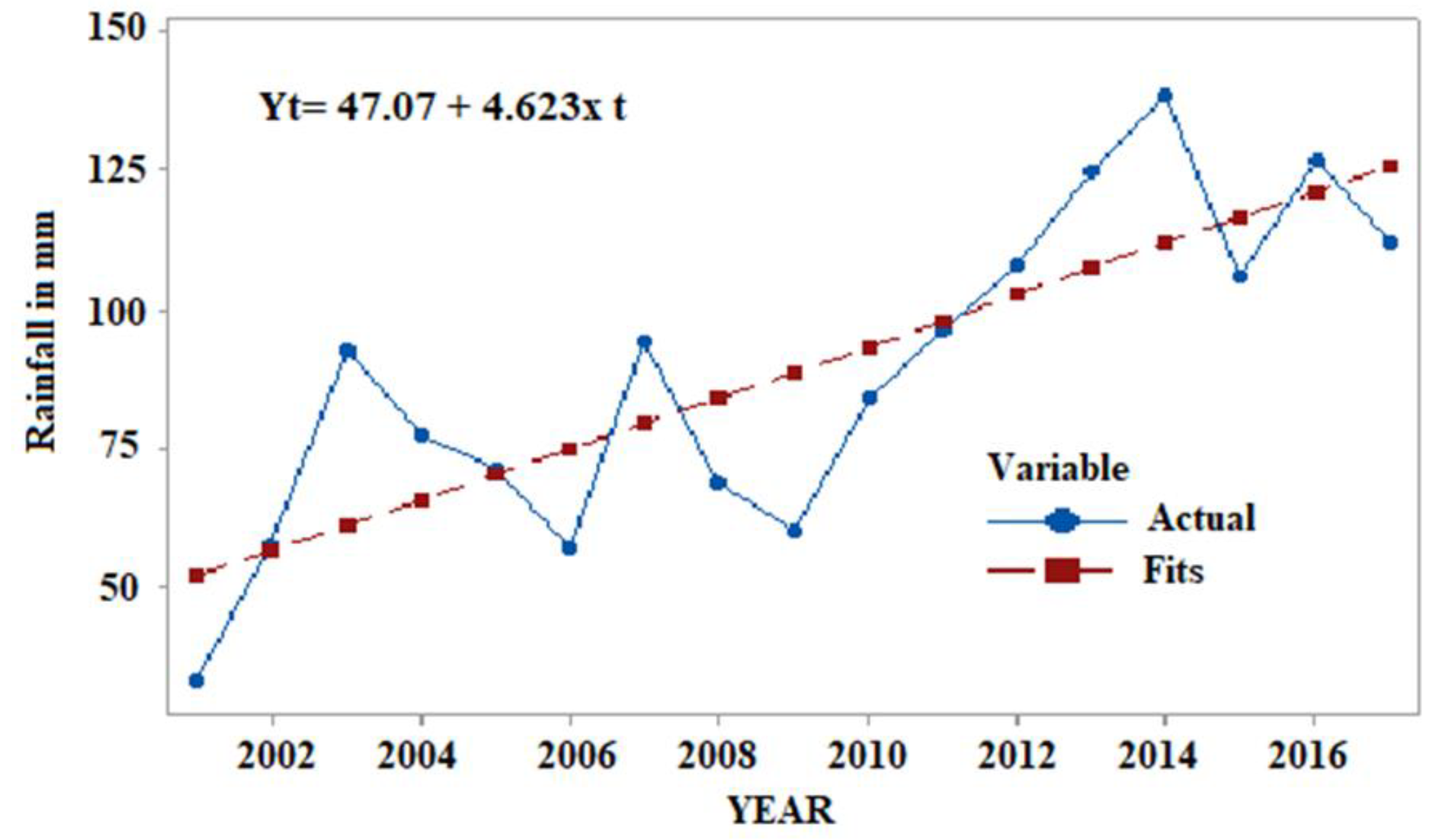
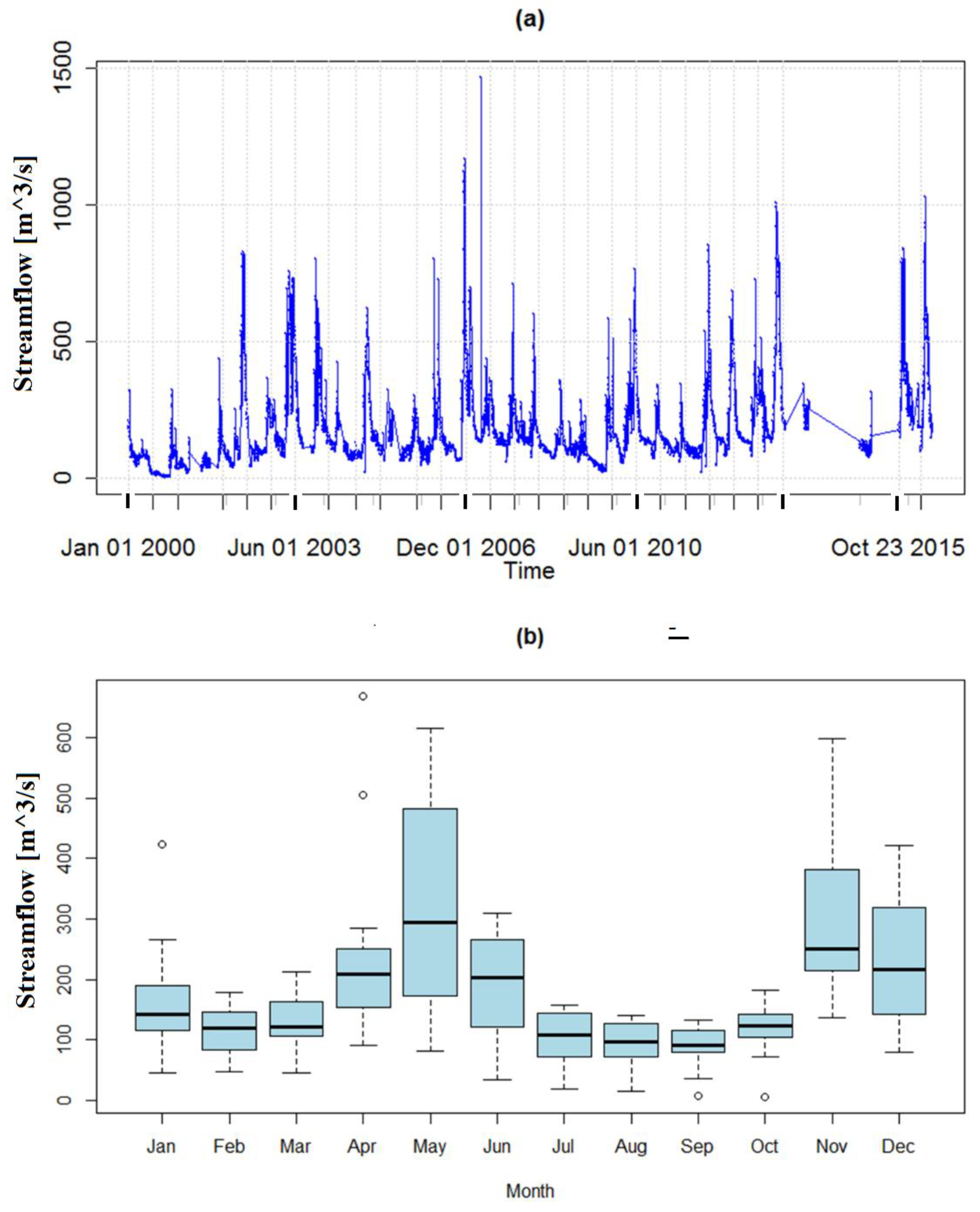
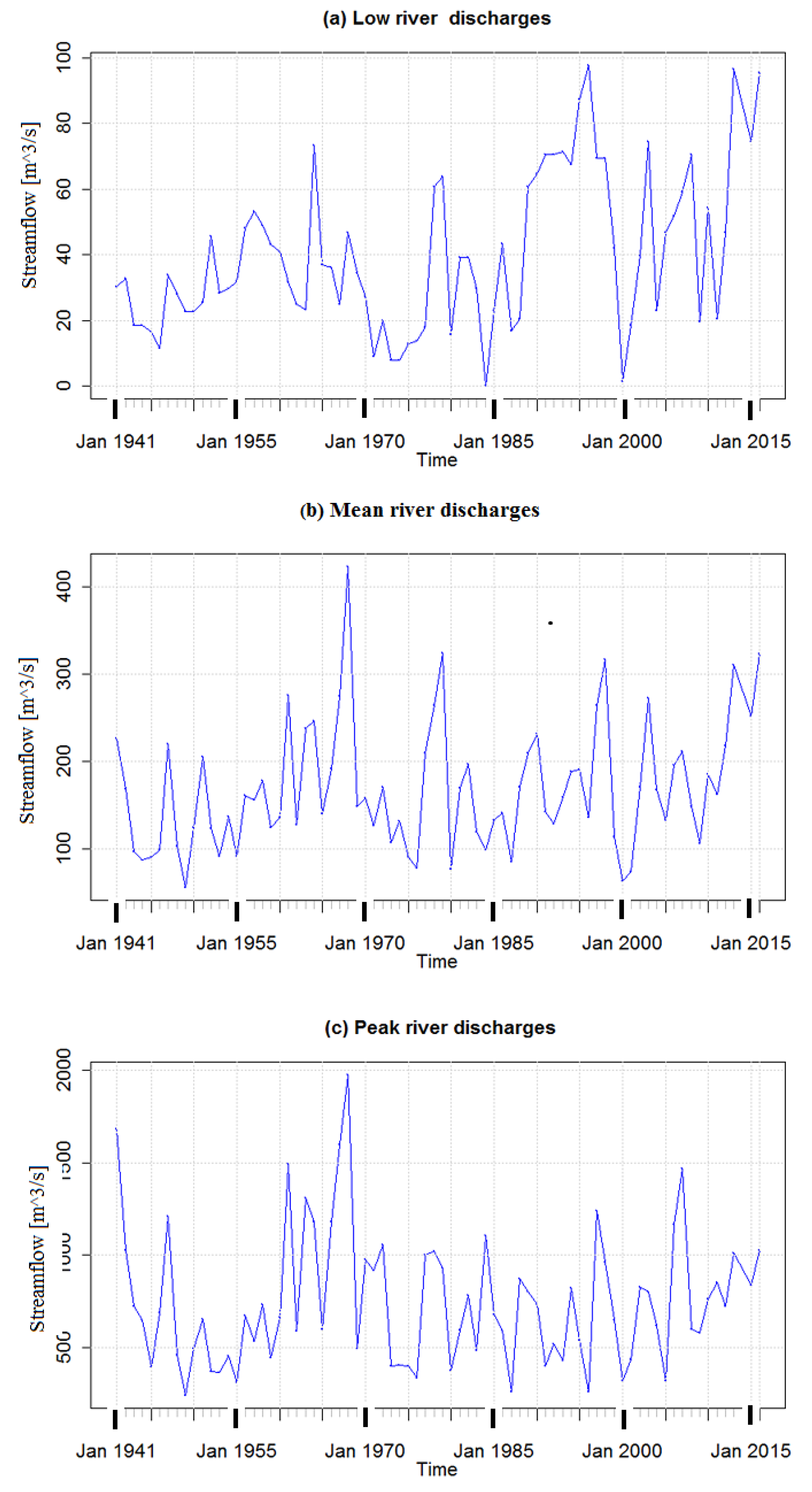
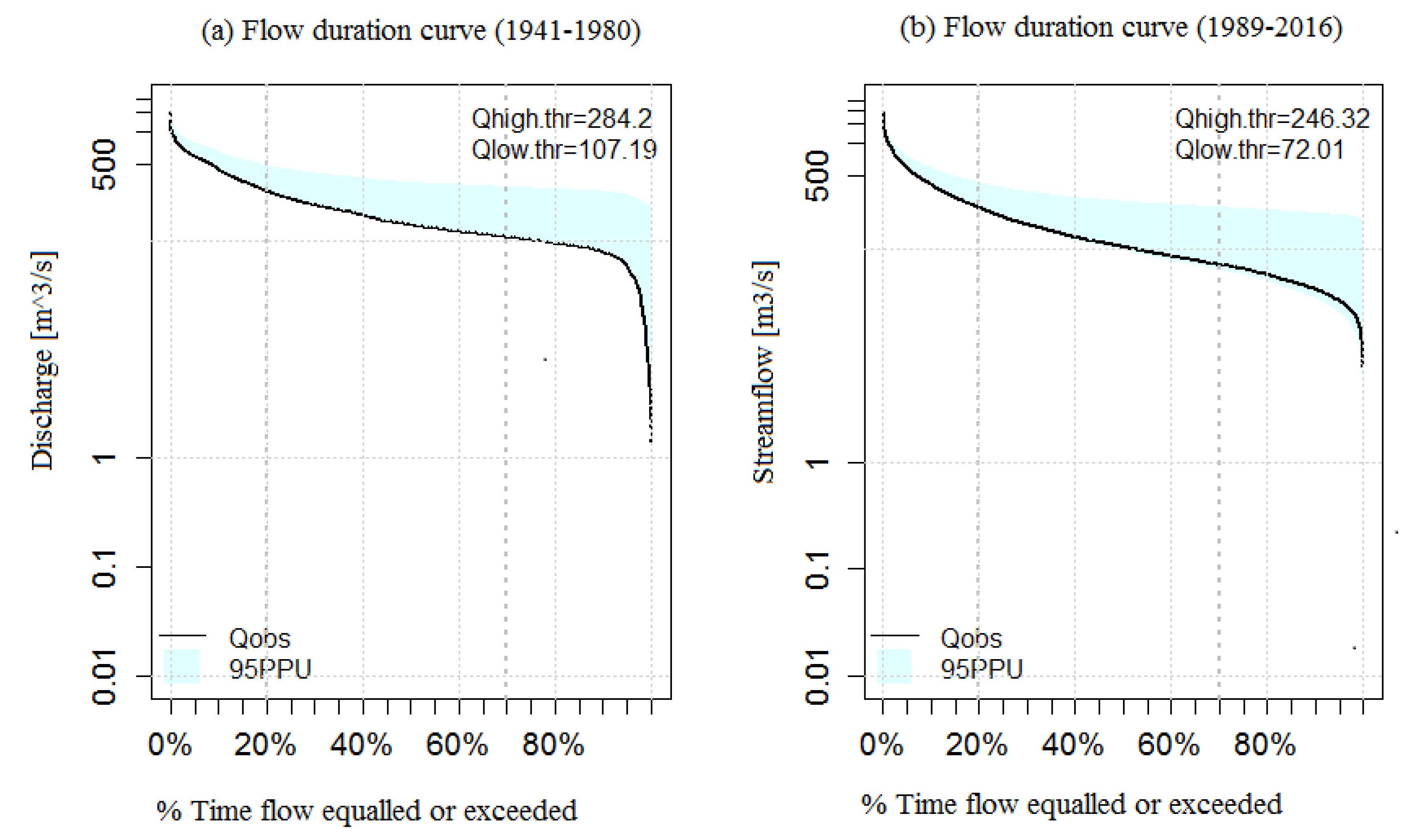

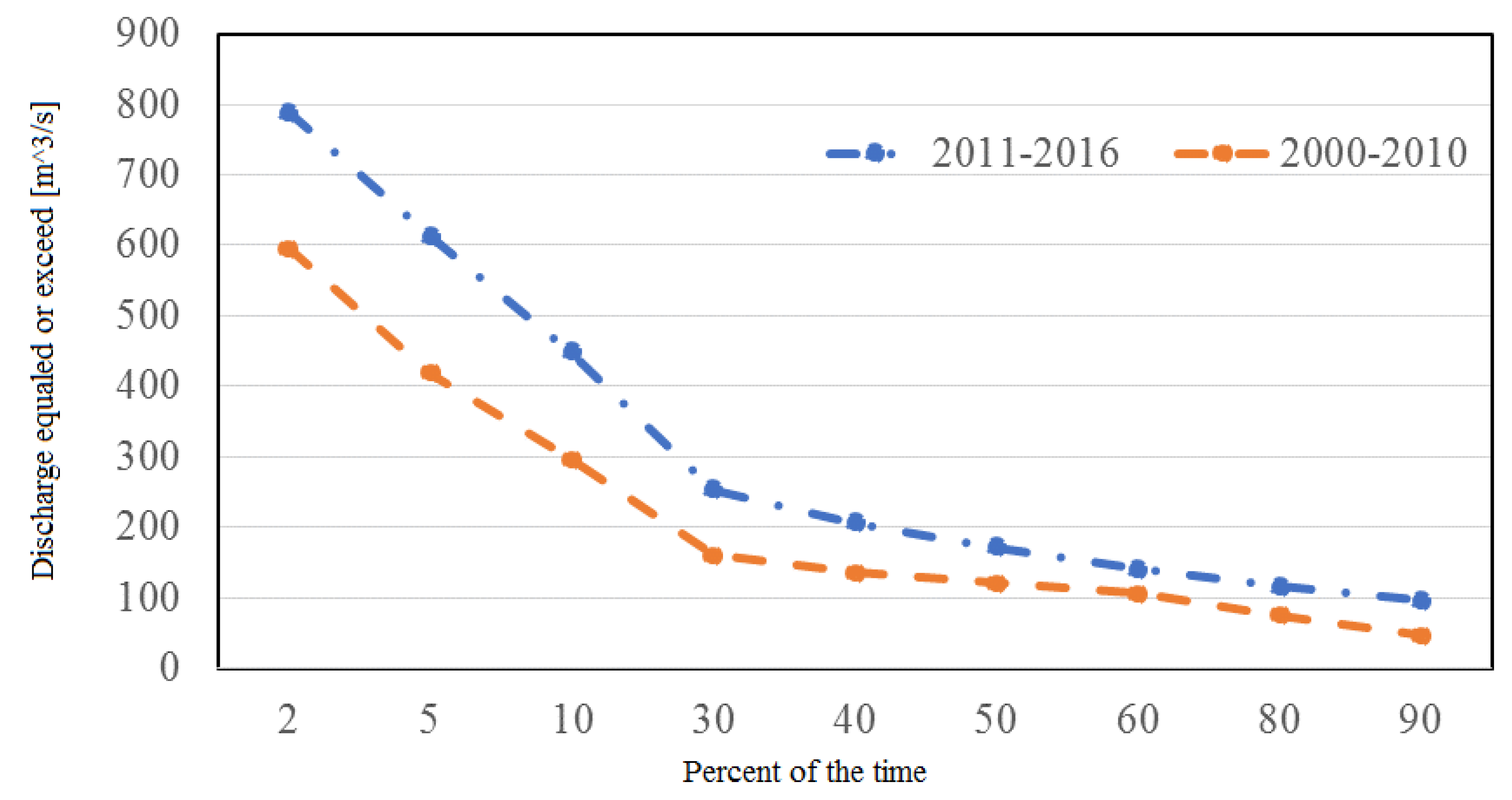

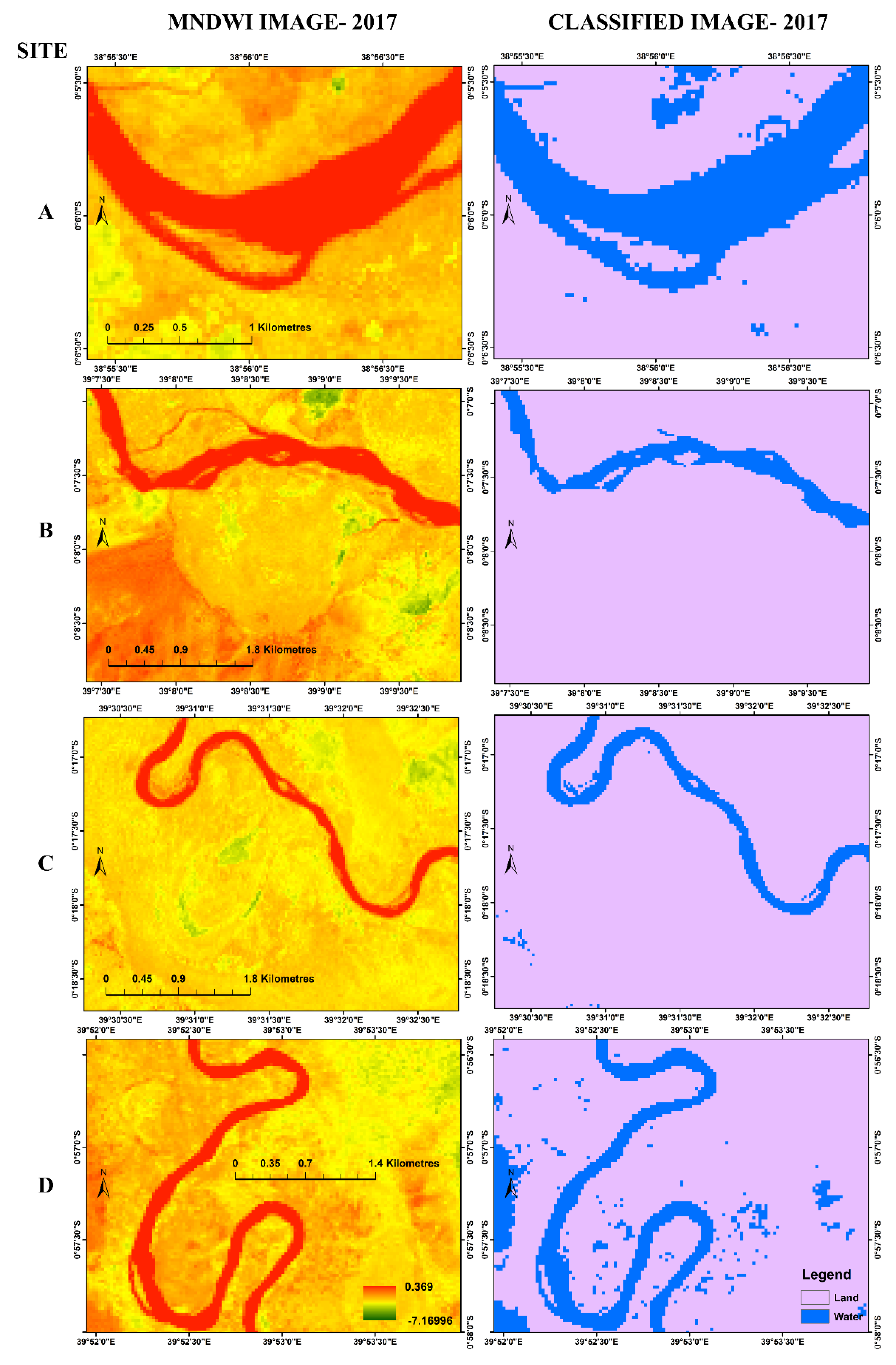
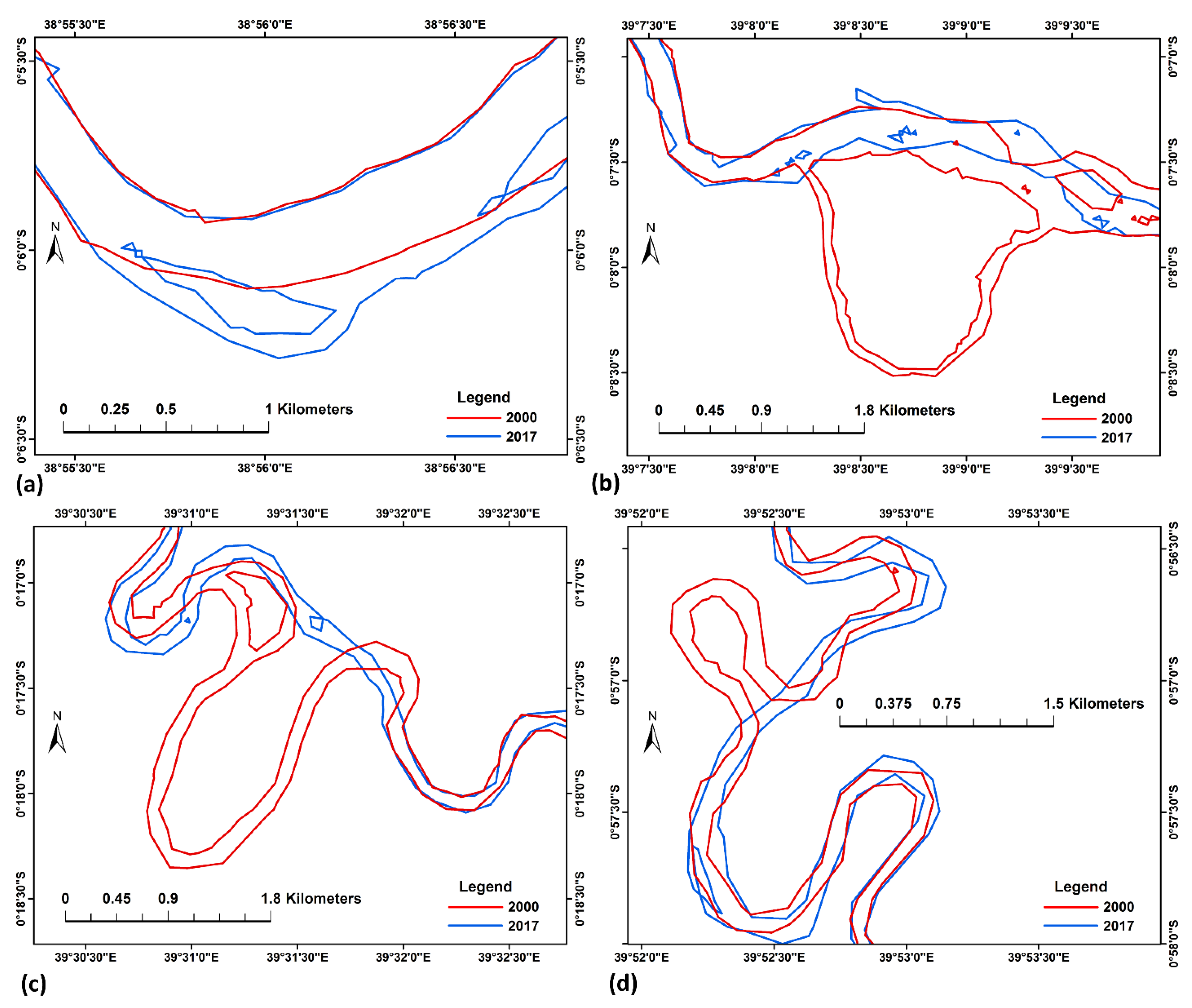
| Reach | Width in m | % Change | |
|---|---|---|---|
| 2000 | 2017 | ||
| A | 383.5 | 420.25 | 8.74 |
| B | 361.5 | 274.83 | −31.53 |
| C | 187.67 | 161.5 | −16.2 |
| D | 141.8 | 144.6 | 1.94 |
© 2019 by the authors. Licensee MDPI, Basel, Switzerland. This article is an open access article distributed under the terms and conditions of the Creative Commons Attribution (CC BY) license (http://creativecommons.org/licenses/by/4.0/).
Share and Cite
Langat, P.K.; Kumar, L.; Koech, R.; Ghosh, M.K. Hydro-Morphological Characteristics Using Flow Duration Curve, Historical Data and Remote Sensing: Effects of Land Use and Climate. Water 2019, 11, 309. https://doi.org/10.3390/w11020309
Langat PK, Kumar L, Koech R, Ghosh MK. Hydro-Morphological Characteristics Using Flow Duration Curve, Historical Data and Remote Sensing: Effects of Land Use and Climate. Water. 2019; 11(2):309. https://doi.org/10.3390/w11020309
Chicago/Turabian StyleLangat, Philip Kibet, Lalit Kumar, Richard Koech, and Manoj Kumer Ghosh. 2019. "Hydro-Morphological Characteristics Using Flow Duration Curve, Historical Data and Remote Sensing: Effects of Land Use and Climate" Water 11, no. 2: 309. https://doi.org/10.3390/w11020309
APA StyleLangat, P. K., Kumar, L., Koech, R., & Ghosh, M. K. (2019). Hydro-Morphological Characteristics Using Flow Duration Curve, Historical Data and Remote Sensing: Effects of Land Use and Climate. Water, 11(2), 309. https://doi.org/10.3390/w11020309





